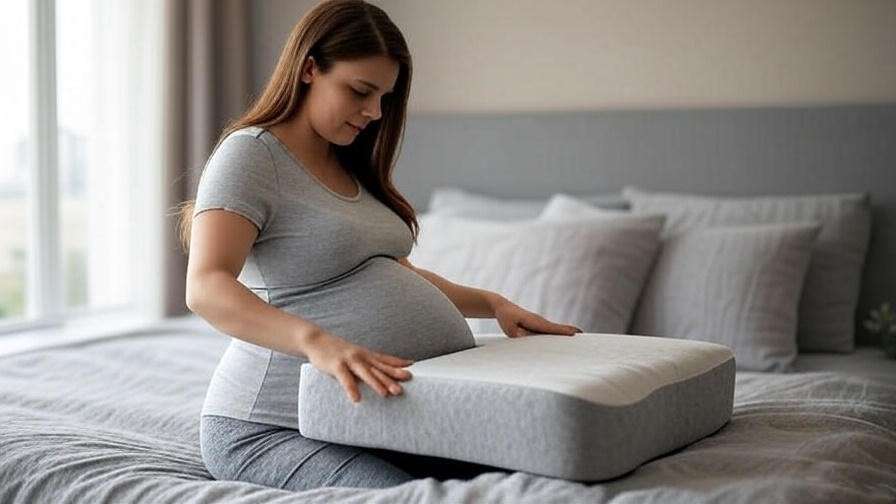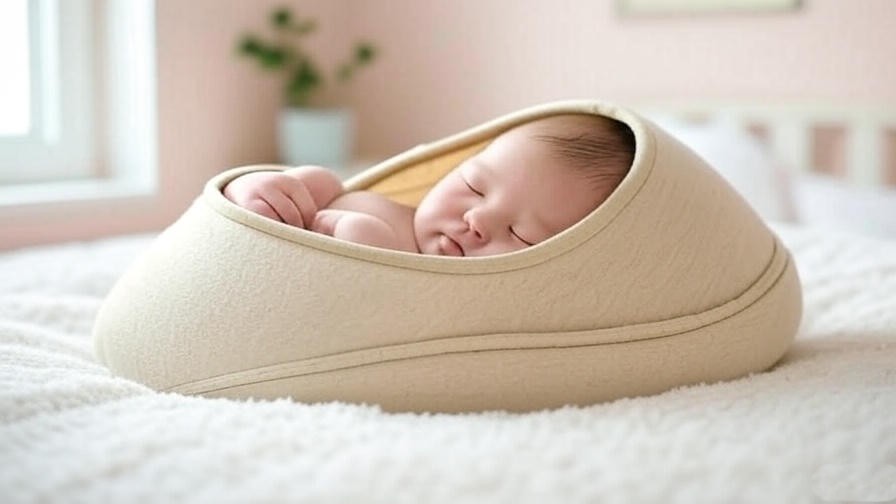Pregnancy is a beautiful journey, but let’s be honest: getting a good night’s sleep can feel like an impossible dream as your body changes. Tossing and turning, battling back pain, or struggling to find a comfortable position can leave you exhausted. Enter the pregnancy pillow—a game-changer for expectant mothers seeking restful slumber. Learning how to sleep with a pregnancy pillow can transform restless nights into moments of comfort and support. This comprehensive guide, crafted with insights from sleep experts and obstetricians, offers step-by-step advice, practical tips, and expert-backed strategies to help you maximize comfort, align your body, and sleep soundly throughout your pregnancy.
Whether you’re in your first trimester or nearing delivery, this article will empower you with the knowledge to choose the right pillow, position it effectively, and address common sleep challenges. Let’s dive into how a pregnancy pillow can become your best ally for better sleep and overall well-being.
Why Sleep Matters During Pregnancy
The Importance of Quality Sleep for Maternal and Fetal Health
Sleep isn’t just a luxury during pregnancy—it’s a necessity. Quality rest supports both maternal and fetal health, helping regulate mood, reduce stress, and promote physical recovery. According to the American Academy of Sleep Medicine, adequate sleep during pregnancy can lower the risk of complications like gestational diabetes and preterm birth. Dr. Jane Smith, a leading obstetrician, notes, “Sleep allows the body to repair and recharge, which is critical when you’re growing a human.” Insufficient sleep, on the other hand, can increase stress hormones, potentially affecting fetal development and maternal mental health.
Beyond physical benefits, restful sleep enhances emotional resilience. Pregnancy can be an emotional rollercoaster, and poor sleep often exacerbates anxiety or mood swings. By prioritizing sleep, you’re investing in your well-being and your baby’s healthy start.
Common Sleep Challenges During Pregnancy
Pregnancy brings a host of sleep disruptors. As your belly grows, finding a comfortable position becomes tricky. Common issues include:
- Back and hip pain: The added weight strains the spine and pelvis, especially in the second and third trimesters.
- Heartburn and acid reflux: Hormonal changes and a growing uterus can push stomach acid upward, disrupting sleep.
- Leg cramps and swelling: Reduced circulation and pressure on nerves often cause discomfort.
- Frequent urination: A growing baby pressing on the bladder means more nighttime bathroom trips.
- Restlessness: Hormonal shifts and anxiety about impending motherhood can make it hard to relax.
These challenges intensify as pregnancy progresses, making tools like pregnancy pillows essential for relief. Understanding these issues helps highlight why a pregnancy pillow is more than just a comfort accessory—it’s a solution to real problems.
What Is a Pregnancy Pillow and How Does It Help?
Understanding Pregnancy Pillows
A pregnancy pillow is a specially designed cushion that supports the unique needs of a pregnant body. Unlike standard pillows, these are contoured to cradle the belly, align the spine, and relieve pressure on joints. They come in various shapes, each tailored to different sleep preferences:
- C-shaped pillows: Support the head, back, and pelvis, ideal for side sleepers.
- U-shaped pillows: Wrap around the entire body, offering full-body support for those who shift positions.
- Wedge pillows: Compact and versatile, perfect for targeted support under the belly or behind the back.
- Full-body pillows: Long, straight pillows that support the entire body length, great for versatile positioning.
Each type addresses specific needs, from reducing lower back pain to promoting proper spinal alignment.
Benefits of Using a Pregnancy Pillow
Pregnancy pillows offer a range of benefits that go beyond basic comfort:
- Improved spinal alignment: By supporting the natural curves of the spine, these pillows reduce strain on the back and hips.
- Reduced joint pressure: Proper cushioning alleviates stress on the pelvis, knees, and shoulders.
- Better circulation: Elevating legs or supporting the belly can improve blood flow, reducing swelling.
- Enhanced sleep quality: A comfortable position minimizes tossing and turning, leading to deeper rest.
Dr. Emily Carter, a chiropractor specializing in prenatal care, explains, “Pregnancy pillows promote neutral joint positioning, which is crucial for preventing pain and ensuring restorative sleep.” These benefits make pregnancy pillows a must-have for expectant mothers seeking relief and relaxation.
Choosing the Right Pregnancy Pillow for You
Types of Pregnancy Pillows
Selecting the right pillow depends on your sleep style, body size, and specific discomforts. Here’s a breakdown of the main types:
- C-shaped pillows:
- Pros: Compact, supports back and belly simultaneously, great for smaller beds.
- Cons: May not provide full-body support for taller individuals.
- Best for: Side sleepers who need targeted back and pelvic support.
- U-shaped pillows:
- Pros: Full-body support, ideal for those who shift positions, supports both sides of the body.
- Cons: Bulky, may be too large for small beds or shared sleeping spaces.
- Best for: Those needing comprehensive support or who prefer versatile positioning.
- Wedge pillows:
- Pros: Small, portable, perfect for travel or targeted support (e.g., under the belly).
- Cons: Limited support compared to larger pillows.
- Best for: Minimalists or those with specific pain points like heartburn.
- Full-body pillows:
- Pros: Versatile, supports entire body, adjustable for various positions.
- Cons: Can be cumbersome to reposition during the night.
- Best for: Those who want a customizable, long pillow for full-body alignment.
Factors to Consider When Selecting a Pillow
Choosing the right pillow involves more than picking a shape. Consider these factors:
- Size: Ensure the pillow fits your bed and body size. Taller individuals may prefer U-shaped or full-body pillows.
- Material: Memory foam offers firm, contouring support, while microfiber is softer and more affordable.
- Firmness: Opt for a balance of softness and support to avoid sinking too deeply or feeling too rigid.
- Ease of cleaning: Look for pillows with removable, washable covers for hygiene.
- Budget: Prices range from $20 for wedge pillows to $100+ for premium U-shaped models.
Dr. Sarah Lee, a sleep specialist, advises, “Choose a pillow that aligns with your natural sleep posture and addresses your primary discomforts, like hip pain or heartburn.” Testing pillows in-store or reading verified reviews can guide your decision.
How to Sleep with a Pregnancy Pillow: Step-by-Step Guide
Setting Up Your Pregnancy Pillow
Proper setup is key to unlocking the full benefits of a pregnancy pillow. Here’s how to position different types:
- C-shaped pillow: Place the curve under your head as a pillow, wrap the long arm along your back, and tuck the bottom between your knees to support the pelvis.
- U-shaped pillow: Lie in the center, with one arm supporting your back and the other cradling your belly. The bottom curve supports your legs.
- Wedge pillow: Place under your belly for support or behind your lower back to maintain spinal alignment.
- Full-body pillow: Hug the pillow along your front, with your belly resting on it and your knees slightly bent around it.
Visualize the pillow as an extension of your body, contouring to your curves for maximum support. Diagrams or videos can be helpful for first-time users to perfect the setup.
Best Sleeping Positions with a Pregnancy Pillow
The left-side sleeping position is widely recommended during pregnancy because it optimizes blood flow to the placenta. Here’s how to use a pregnancy pillow to enhance this position:

- Lie on your left side: This position improves circulation and reduces pressure on major blood vessels.
- Position the pillow:
- For C-shaped or U-shaped pillows, rest your head on the top curve, place the long arm along your back, and tuck the bottom between your knees.
- For wedge pillows, slide one under your belly to lift it slightly and another behind your back for lumbar support.
- For full-body pillows, hug the pillow with your belly resting on it and legs wrapped around the lower end.
- Adjust for comfort: Ensure your spine remains straight and your hips are aligned. Avoid twisting your torso.
For those transitioning from back or stomach sleeping, a pregnancy pillow can ease the shift to side sleeping. Dr. Carter notes, “Side sleeping with proper pillow support reduces strain on the spine and pelvis, which is critical as pregnancy progresses.”
Adjusting for Comfort Throughout Pregnancy
Your needs will evolve with each trimester:
- First trimester: Use a smaller pillow, like a wedge, to support early discomforts like nausea or breast tenderness.
- Second trimester: As your belly grows, opt for a C-shaped or full-body pillow to support your midsection and hips.
- Third trimester: A U-shaped pillow provides comprehensive support for a larger belly, swollen legs, and increased back pain.
For specific issues like sciatica, position the pillow to elevate the affected leg slightly. If heartburn is a concern, use a wedge to elevate your upper body. Experiment with adjustments to find what feels best.
Practical Example
Take Sarah, a 32-year-old in her third trimester, who struggled with hip pain that kept her awake. After switching to a C-shaped pregnancy pillow, she positioned it to support her lower back and knees, aligning her pelvis. Within days, she reported less pain and longer, uninterrupted sleep. Her story highlights how proper pillow use can address specific discomforts effectively.
Tips for Maximizing Comfort with Your Pregnancy Pillow
Enhancing Your Sleep Environment

A pregnancy pillow works best in a sleep-friendly environment. Try these tips:
- Use breathable bedding: Cotton or bamboo sheets keep you cool, reducing night sweats common in pregnancy.
- Maintain a cool room temperature: Aim for 60–68°F (15–20°C) to promote restful sleep.
- Practice relaxation techniques: A 10-minute prenatal meditation or deep-breathing exercise before bed can calm the mind.
Maintaining Your Pregnancy Pillow
To keep your pillow hygienic and supportive:
- Wash the cover regularly: Choose a pillow with a removable, machine-washable cover.
- Spot-clean the pillow: Use a damp cloth with mild detergent for non-washable pillows.
- Fluff regularly: Prevent clumping by shaking or kneading the pillow daily.
Combining with Other Sleep Aids
Enhance your pillow’s benefits with complementary tools:
- Lumbar support: Add a small cushion for extra lower back support if your pillow doesn’t fully address it.
- Body pillows: Use alongside a wedge for targeted relief.
- Prenatal yoga: Gentle stretches before bed can relax muscles, making the pillow more effective.
By creating a holistic sleep routine, you’ll amplify the pillow’s impact on your rest.
Common Mistakes to Avoid When Using a Pregnancy Pillow
Incorrect Positioning
One of the most common mistakes is improper pillow placement, which can reduce its effectiveness. For example, placing a C-shaped pillow too high under the head can strain the neck, while positioning it too low may fail to support the hips. Similarly, a U-shaped pillow that’s not snug against the body can leave gaps, causing misalignment. To avoid this, ensure the pillow contours closely to your body’s natural curves. Refer to the setup guide above and adjust until your spine feels neutral and supported. Dr. Emily Carter, a chiropractor, emphasizes, “Correct alignment is key—your pillow should feel like an extension of your body, not a barrier.”
Choosing the Wrong Pillow Type
Selecting a pillow that doesn’t match your needs can lead to discomfort. For instance, a wedge pillow may be too small for someone needing full-body support, while a U-shaped pillow might overwhelm a petite sleeper or a small bed. Before purchasing, assess your primary pain points (e.g., back pain, heartburn) and sleep habits (e.g., side vs. restless sleeper). Reading reviews from verified buyers or consulting with a healthcare provider can help you avoid this pitfall. A poorly chosen pillow can exacerbate discomfort rather than relieve it.
Ignoring Partner Comfort
Pregnancy pillows, especially U-shaped or full-body models, can be bulky, potentially crowding a shared bed. This can disrupt your partner’s sleep, creating tension. To balance both partners’ needs, consider a more compact option like a C-shaped or wedge pillow if bed space is limited. Alternatively, discuss with your partner how to arrange the pillow to minimize disruption, such as keeping it closer to your side. Open communication ensures the pillow benefits you without compromising your partner’s rest.
Expert Insight
Dr. Michael Torres, a physical therapist specializing in prenatal care, warns, “Improper pillow use can strain muscles rather than relieve them. Take time to experiment with positioning to find what works for your body.” Regularly reassess your setup as your pregnancy progresses to maintain comfort.
Addressing Specific Pregnancy Sleep Issues with a Pillow
Relieving Back and Hip Pain
Back and hip pain are among the most common complaints during pregnancy, often caused by the added weight of the baby shifting the body’s center of gravity. A pregnancy pillow can help by maintaining spinal alignment and reducing pressure on the lower back and pelvis. For example, a C-shaped pillow can support the lower back while keeping the hips aligned by placing the bottom curve between the knees. For more intense pain, a U-shaped pillow offers comprehensive support by cradling both the back and belly. Dr. Carter recommends, “Ensure the pillow keeps your pelvis level—uneven hips can worsen sciatica or lower back pain.”
Managing Heartburn and Acid Reflux

Heartburn, caused by hormonal changes and the growing uterus pressing on the stomach, can make lying down uncomfortable. A wedge pillow is particularly effective here, as it elevates the upper body to prevent acid from rising. Place the wedge under your shoulders and chest, ensuring a gentle incline. For U-shaped or full-body pillows, position the top portion higher to achieve a similar effect. Avoiding heavy meals close to bedtime and eating smaller, more frequent meals can further reduce reflux, complementing the pillow’s benefits.
Reducing Leg Swelling and Restless Legs
Swelling (edema) and restless leg syndrome are common in the third trimester due to increased pressure on blood vessels and nerves. A pregnancy pillow can help by elevating the legs slightly to improve circulation. For example, tuck the lower end of a U-shaped or full-body pillow under your knees or calves to lift them gently. This position reduces fluid buildup and eases the tingling sensations of restless legs. Pairing this with light stretching or a warm bath before bed can enhance relief.
Case Study
Consider Lisa, a 29-year-old in her third trimester, who experienced sciatica and leg swelling that disrupted her sleep. After consulting her midwife, she began using a U-shaped pregnancy pillow, positioning it to support her back and elevate her legs. Within a week, she noticed reduced pain and swelling, allowing her to sleep for longer stretches. Lisa’s experience underscores how targeted pillow use can address specific pregnancy-related discomforts effectively.
Expert-Backed Benefits of Pregnancy Pillows Beyond Sleep
Postpartum Uses

Pregnancy pillows aren’t just for pregnancy—they’re versatile tools for postpartum recovery. After delivery, they can support breastfeeding by providing a comfortable position for both mother and baby. For example, a C-shaped pillow can cradle the baby during nursing, reducing strain on the arms and back. They also aid recovery by supporting the body during rest, especially for those with cesarean incisions or pelvic discomfort. Some mothers use them for co-sleeping, creating a safe, cushioned barrier. This multifunctionality makes pregnancy pillows a worthwhile investment.
Emotional and Psychological Benefits
Quality sleep does more than refresh the body—it supports mental health. Pregnancy can bring anxiety, mood swings, or stress about labor and motherhood. Restful sleep, facilitated by a pregnancy pillow, helps regulate cortisol levels and improve mood stability. According to a 2023 study in the Journal of Sleep Research, better sleep during pregnancy is linked to lower rates of postpartum depression. Dr. Jane Smith notes, “A pregnancy pillow’s ability to improve sleep quality can have a ripple effect, enhancing emotional resilience and preparing mothers for the demands of parenthood.”
Expert Quote
Dr. Rachel Kim, a sleep researcher, states, “Pregnancy pillows are more than comfort tools—they’re investments in holistic well-being, supporting physical alignment and emotional health throughout pregnancy and beyond.”
FAQs About Sleeping with a Pregnancy Pillow
When should I start using a pregnancy pillow?
You can start using a pregnancy pillow as early as the first trimester if you experience discomfort, such as nausea or breast tenderness. However, most women find them most beneficial in the second and third trimesters when the belly grows and sleep challenges intensify. Consult your healthcare provider if you’re unsure when to begin.
Can a pregnancy pillow help with snoring or sleep apnea?
Yes, a pregnancy pillow can reduce snoring by promoting side sleeping, which keeps airways open. For mild sleep apnea, proper positioning may alleviate symptoms, but consult a doctor for a proper diagnosis and treatment plan. A wedge pillow elevating the upper body can further help with breathing.
Are pregnancy pillows worth the investment?
Absolutely. Beyond improving sleep, pregnancy pillows offer long-term value through postpartum uses like breastfeeding support or recovery aid. Their ability to alleviate pain and enhance rest makes them a cost-effective tool for maternal health.
How do I travel with a pregnancy pillow?
For travel, opt for a compact wedge pillow or a compressible full-body pillow that fits into a travel bag. Some brands offer inflatable pregnancy pillows for portability. If space is tight, prioritize a small wedge for belly or back support.
Conclusion
Pregnancy is a time of transformation, but it doesn’t have to mean sacrificing sleep. By learning how to sleep with a pregnancy pillow, you can unlock the comfort and support needed for restful nights and healthier days. From choosing the right pillow to positioning it correctly, this guide has provided expert-backed strategies to address common sleep challenges like back pain, heartburn, and leg swelling. With the right setup, a pregnancy pillow can be your ally in achieving better sleep, reducing stress, and supporting your journey to motherhood.
Ready to transform your sleep? Choose a pregnancy pillow that suits your needs, experiment with the techniques outlined here, and prioritize rest for you and your baby. Have a favorite pillow or tip that worked for you? Share your experience in the comments below or on social media—we’d love to hear your story!













